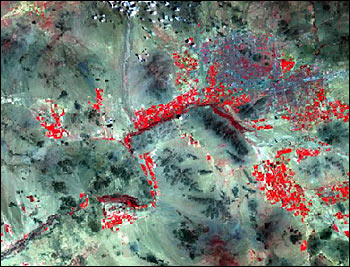| |
According to Moran, an optimum remote sensing system for
precision farming would provide data as often as twice per week for
irrigation scheduling and once every two weeks for general crop damage
detection. The spatial resolution of the data should be as high as 2 to
5 square meters per pixel with positional accuracy of within 2 meters.
Additionally, the data must be available to the farmer within 24 hours
of acquiring them.
Turnaround time, she says, is more important to farmers than data
accuracy. They would gladly accept remote sensing measurements that are
as poor as 75 percent accurate if they were assured of getting them
within 24 hours of acquisition. Unfortunately, says Moran, there are
currently no Earth orbiting satellites that can meet all of a precision
farmer’s requirements. But she is optimistic that this will change
within the next 10 years as exciting new satellite remote sensing
technologies emerge. Until that time, there are still a variety of
sources of remote sensing data that farmers can use.
|
|
|
| |

For instance, the Enhanced Thematic Mapper Plus (ETM+) aboard Landsat
7 and the Advanced Spaceborne Thermal Emission and Reflection Radiometer
(ASTER) aboard Terra provide good spatial and spectral resolution (up to
15 meters per pixel) as well as good scientific calibration accuracy.
But used by themselves these satellites’ revisit cycles are too
infrequent to be of use to precision farmers. Moran is also interested
in the new Advanced Land Imager (ALI) and the hyperspectral Hyperion
sensor aboard the newly launched EO-1. But none of these satellite
sensors have the desired temporal resolution, as they "see" a
given patch of ground only once every 16 days, on average. The Moderate
resolution Imaging Spectroradiometer (MODIS), aboard Terra, sees a given
patch of ground almost every day (high temporal resolution), but its
highest spatial resolution is only 250 meters per pixel–too coarse
for precision farming but perfect for regional to global-scale
research.
Moran points out that precision farmers may use a combination of
satellite and airborne remote sensing data to meet their needs. There
are a growing number of commercial companies that serve their local
regions by flying remote sensors aboard aircraft that collect data in
visible and near-infrared channels at spatial resolution ranging from
0.3 to 1 meter per pixel and have turnaround times of less than 24
hours. For instance, it may be possible to purchase commercial
overflights periodically during the growing season to fill in the gaps
between acquisitions of satellite remote sensing data.
Moran uses a computer model to integrate the various data into a
simulation of the growing conditions in the field. The model allows her
to overcome some of the spatial and temporal limitations in the Landsat
7 data by interpolating or predicting the changes that occur over time
and space that the satellite cannot see.
Ultimately, where does Moran see all this new precision farming
technology heading? She envisions a day when commercial companies can
serve farmers with new scientific tools that she calls "decision
support systems." In much the same way banks and brokerages provide
financial advice and accounting services to business persons, there will
be companies using decision support systems to routinely map field
boundaries as well as weed, pest, or disease outbreaks. These companies
will track when a farmer plants, waters, and applies fertilizers or
other chemicals. Based upon all this information, the companies will
help the farmers develop good precision management strategies throughout
the year to maximize their harvest yields while saving them time and
money.
"In a dream world, this is what should be happening," Moran
muses. "That would be the entire precision agriculture application
in a nutshell. We don’t yet have such a system. But do we have
the technology to build one? Yes!"
- References
- Moran, M.S. and J. Irons, 2000: "New imaging sensor technologies suitable for agricultural management," Intl. J. Rem. Sens. (submitted).
- Moran, M.S., 2000: "Technology and techniques for remote sensing in agriculture," Assoc. Appl. Biol. and Rem. Sens. Soc. Conf. on Remote Sensing in Agriculture; June 26-28, Cirencester, England; p. 1-10.
- Moran, M. Susan, 2000: "Image-Based Remote Sensing for Precision Crop Management–A Status Report." Proceedings of the Conference American Society of Civil Engineers; Feb. 27-March 2, pp. 185-93.
- Moran, M. Susan, 2000: "Image-Based Remote Sensing for Agricultural Management–Perspectives of Image Providers, Research Scientists, and Users." Proceedings of the 2nd International Conference on Geospatial Information in Agriculture and Forestry; Jan. 10-12.
- Moran, M. Susan, Y. Inoue, and E.M. Barnes, 1997: "Opportunities and Limitations for Image-Based Remote Sensing in Precision Crop Management." Remote Sensing of the Environment, vol. 61, pp. 319-46.
 At the Right Place and Time At the Right Place and Time
|
|
This false-color image was
acquired by Landsat 7's Enhanced Thematic Mapper Plus (ETM+) in August
1999 over the Maricopa Agricultural Center in central Arizona. Bright red areas
are irrigated fields. According
to Susan Moran, although most satellite sensors currently lack the
desired spatial and temporal resolution, they may still prove to be
valuable information resources for precision farmers as these data are
incorporated into better computer models that allow farmers to
interpolate how growing conditions change over time and
space. (Image courtesy Susan Moran, Landsat 7 Science Team) |

